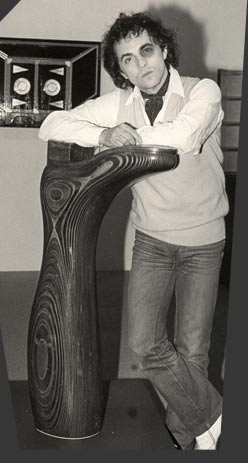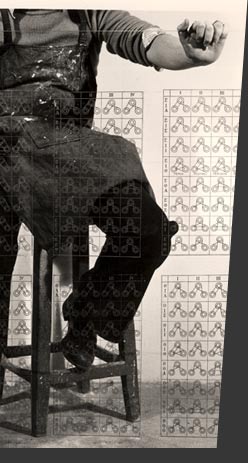Ugo Nespolo
Ugo Nespolo graduated from the Accademia Albertina with Enrico Paolucci and immediately warned the final run out of an accademic and provincial season, exploring new possibilities in the terms of choices not only expressive, but, broadly speeking, intellectual. He has a very strong relationship with the leading elements of culture in Turin. In his first two solo exhibitions (Ugo Nespolo and the Logic of Puzzles) at the Punto Gallery in Turin, he was introduced by the texts of Edoardo Sanguinetti, at the time, recognized as the leader of the new avant-garde, the so called Group 63 where also Renato Barilli belonged, with critics such as Crispoldi, Trini, Celant, Dorfles and Caramel, who followed the debut of the young artist. Not to mention Ben Vautier, who gives a sharpe description of Nespolo: “Nespolo est ambitieux. Nespolo est jaloux. Nespolo est hypocrite. Nespolo est mèchant. Nespolo est menteur et rusè. Nespolo est dèvorè de prètention. C'est un loup. Il se porte bien”
In Turin, Albino Galvano, professor of philosophy, played an important role in intellectual promotion and was the first to feel the need of a renewal, not only superficial, participating at the MAC esperience with another “erethic” from Turin, Carol Rama. Galvano (who presents in 1966 the drawings of Lux mundi) was in contact with the academics of the magazine Sigma, who were updating their critical positions under methodological acquisitions, especially structuralism and semiotics from beyond the Alps.
The meaning was to keep the distance from the prevailing and increasingly oppressive hegemony
“crociana” (as it use to be with Gramsci, to justify neorealistic operations). In Turin Luigi Pareyson who teached esthetics and moral philosophy, stated the important “theory of formativity, that means “to do”, but while “doing” you invent the way to “do it”; it was a strong appeal, not only to the concept of poetic, but also to the process of elaboration-construction of the masterpiece. Pareyson's students were Umberto Eco and Gianni Vattino, who are still in contact with Nespolo.
In the historical location in Turin of the Einaudi, in Biancamano street, Italo Calvino in the meantime worked, founded with Vittorini the magazine “Il menabò”, and dedicated in 1964 a unique copy all about the discussion between industry and literature. In 1967 Calvino published the essay “Cybernetica e fantasmi”, attended the seminary of Roland Barthes in Paris, established a relationship with the group of the Oulipo and in particular with Raymond Queneau. But Queneau was also friends with Enrico Baj, with who Nespolo opens in Milan, in 1972, the Rewarded Studio Nespolo & Baj. No wonder then, if Nespolo publishes in 1968 a book of formal logic “Truth and lies” with an interest in the “science of imaginary solutions” that is the pataphysics of Jarry creating the Antidogma Association.
It is Jarry who inspires a movie like “Supermaschio”, were the bust of Joseph Beuyes moves freneticly (follows in 1978 and 1982 “Lo spaccone” and “Le Porte girevoli”). Nespolo started precociously his passion for movie films with Mario Schifano, at the Cinema for Artist inspired by the New American Cinema. Between 1967 and 1968 he realizes movies like Grazie Mamma Kodak, La galante avventura del cavaliere del lieto volto, Le gote in fiamme, Neonmerzare, Buongiorno Michelangelo, Boettinbiachenero, Tucci-Ucci, starring his friends Enrico Baj, Lucio Fontana, Mario Merz, Michelangelo Pistoletto, Alighiero Boetti. In Milan, thanks to Fernando Pivano, he meets the most significant representatives of the beat generation Jack Kerouak and Allen Ginsberg, who becomes the leading actor of the movie A. G. (1968). The movie experience will last for years, offering many retrospectives dedicated to him at Museums, Galleries Foundations and Cultural Institutes (such as Philadelfia Museum of Modern Art, Centro de Arte Y comunicacion Elpidio Gonzalez, Antwerpen, Belgium, Musèe du Cinema, Palais de Chaillot, Paris, BFI National Film Theatre, The London Film Makers Co-Op, Hayward Gallery, London, Filmoteka Polska, Istituto di Cultura Napa di Solidarnosc, Museo Nazionale Varsavia, Istituti Italiano di Cultura, Cineteca Wallraf-Richartz-Museum, Colonia, Pechino e Shanghai, Ufficio Cinema Cinese, Film Festival International Shanghai, MK Ciurlionis National Museum of Art Kaunas Lituania, up to Beauboug of Paris (with the review of 1984 “Le cinema diagonal” and in 2001 “film/a/to” with Edoardo Sanguinetti (very important for Nespolo's first movie season is the volume “La fugace vita di fotogrammi” dated 1978 dedicated to him by Vittorio Fagone.
The interactive relation between the arts, which required a different relationship with the public had been raised by the international movement, inspired by the personalities of Maciunas, Beuys, John Cage e Joko Ono – of Fluxus, in which Nespolo is interested in and that brings to Turin the Concert Fluxus “Le mots et les choses” with Ben Vautier, Boetti, Sanguinetti, Lora Totino (Gallery Il Punto, april 26-28 1967). Rather than Paris, that watched the decay of it's artistic and cultural role, the glance was towards New York, where he stays for a long period, after opening a studio on West Broodway and participating to many exhibitions at the Arras Gallery between 1973 and 1985 (an exhibition in 1981 is greeted by an article of Furio Colombo on the newspaper La Stampa of Turin “Un marziano della pittura sbarca a New York”. He enjoys life as a newyorker, looking up at the skyscrapers or lowering his eyes to look into the widows of the shops. (like his paintings: Fuga da New York 1986, Quando la città dorme 1989, Soft New York 1999, Vetrine di New York 1989) In America, the decline of the informal gave life to Pop Art, that Nespolo admires, always keeping his european avant-garde traditions. From Futurism to Dada, Depero offers him a model of art, in a context of everyday life. An on the base of this conviction, Nespolo starts his period of Arte Povera, placing his name on the famous poster of the exhibition Con-temp l'azione (Gallery Christian Stein/Il Punto, Turin 1967)designed by his friend Alighiero Boetti, toghether with the others, the “10 from Turin” of the group (Piacentini, Merz, Zorio, Pistoletto, Ceroli, Mondino, Gilardi, Anselmo).
The width of these openings in a non usual artist, goes beyond the choice, that remains although fundamental, of the pictorical vocation, but is needed to enrich it of numerous contributions and resonances, besides the deep critic awareness. Artist and man of culture, he has the firm belief that practising art cannot leave out the reflection on art. Art critic, (two recent participations dedicated to Cézanne and Picasso on “The Stampa” of Turin), Nespolo explains his conception in a book “Arte & vita” 1998 in which he re-elaborates his degree thesis in semiology, discussed with Gian Paolo Caprettini at the University of Turin. Nespolo claims the necessity to contaminate himself in the middle of the crowd, adapting art to his demands, leading art to the circuit of everydays existance. This model is offered by Futurist art houses such as Balla, that were in the projects, in the famous poster of 1915 in a futurist reconstruction of the universe. (La casa d'arte Nespolo, is the title of the anthologic of 1995 at the Palazzo della Permanente in Milan) Here begins the attention to the design, and the assiduous practice of applied art that brought Nespolo to the most disparate sctors, from clothing industry, to interior design, from book covers to graphic design for the Campari advertisement, for the Richard Ginori (also artistic director of the Ginori Museum). Fundamental is the creation of posters for important cultural and sports events from Azzurra to the World Soccer Cup, to the Cycling Tour of Italy. A major pronounced impact on the environment are the “Artist lights” for the Gru Department stores in Turin and the billboards along the subway stations that recall episodes of the ancient and modern history of the city. In this concept the attention for the materials is not only visual but also tactile (wood, metal, bronze, like for the sculpture he made for the city of San Benedetto del Tronto “Lavorare, lavorare, lavorare, preferisco il rumore del mare” inaugurated by his friend Renzo Arbore, ceramic, glass for Barovier & Toso of Murano, different kinds of fabrics, including rugs and precious stones for the exhibition at the Gallery Blu in Milan in 1974 “Alabastro, argento, avorio, ebano, lacca, seta, smalto”. Nespolo also designed the scenery and costumes for opera's such as Turandot of Busoni, Don Quixote of Paisiello, Elisir d'amor of Donizetti and Madame Butterfly of Puccini and also took care of the tour of singer Ivano Fossati in year 2000 and collaborated with Luciano Berio and Severino Gazzelloni and for the booklet of the comic opera “Al museo in volo& a zompi” 1996 with the music of Giulio Castagnoli. Along with the passion for music comes the passion for books (qualified and assiduous book collector, he has a extraordinary collection of the first futurist editions). He also published a book of irreverent poems “Nella riserva circondata da cowboys”, he illustrated important literature opera's such as The Magificat of Alda Merini and poems of Gozzano. In this circular kaleidoscopic of these connections even the musical notes, numbers, letters of the alphabet and books become the animated subject and image of a pictorial work. The basis of these developments are to be found in the statement supported by Pierre Restany who in 1968 presented “Macchine e oggetti condizionali” a one man exhibition at the Schwarz Gallery in Milan. Nespolo's universe is made of objective reconstruction (the exact opposite of what Nouveau Realisme did, started out by Restany a couple years before) In his constructions, in the way he covers the objects with spots of paint, or in his puzzles (cut out forms deliminated in spaces to be put toghether) It seems that his vision of the world approaches reality throughout a succession of layers. His reality does not impose as a immediate, total, enlightened revelation, but is half way between the single object and its direct appropriation. Nespolo's objects and forms live at conditional and not at indicative. They affirm and don't force there presence. The puzzle tecnique becomes an identification of Nespolo's work (but not the only). He got the idea from the game of that children played. Nespolo cuts out and puts toghether pieces of wood interlocking them and making irregular figures, mostly monochrome into a combination of polichrome images. And the “Logic of puzzles” title of the above mentioned exhibition involves a serie of details that concerns the popular comunication (the posters of Marylin from Andy Warhol, Lichtenstein's comics) the elegant expressions of culture and art. The classical sculptures from the Bargello exhibition in Florence in 2009. All this to combine the different methods of creative experience. These are characteristics of postmodern as Eco wrote in his “Postille” In the name of the rose. But the time comes that the modern cannot go any further, because it produces a metal language that talks about its impossible text (conceptual art). The answer to this is to recognize that the past cannot be destroyed because distruction leads to silence, but it must be revised with irony in a non innocent way. Irony and the absense of innocence are signals of a critical separation, a consciousness that if it does'nt refuse “the pleasant” (another term used by Eco) it emphasizes the fact that every language is conventional and arbitrary. Neverless Nespolo refuses the fundamentals of a “weak thought” but reacts to the crisis of its innovative operating proposals on the basis of what we can define as “ethic” of the making action.
The splendid series of paintings inspired to famous movies (esposed at the exhibition “Effetto pittura” in 1994) where the image blends into the movement of the action concentrating and expanding the intrinsic beat of the story. “The Museum” a large painting presented in Livorno in 1976, where 9 visitors seen from behind are looking at famous paintings of other famous artists. This is a “mise en abyme” of the painting of others, that Nespolo revises and re-invents as in “Le recit speculaire” a book of Lucien Dallenbach that talks about the phenomenum of the “mise en abyme” (in the literature ambit). But The Museum was already an arrival point as it gathers toghether paintings dedicated to a single artist and his audience (as for example Andy Dandy dedicated to Andy Warhol or Guardar Morris in 1973/74).At the same time it was also a starting point that gave origin to a series faithful to its matrix, but capable to create new influences formal and figurative as mentioned in 1982 in “L'artista e il suo doppio” (in the wonderful catalogue of Marescalchi-Allemandi Storie di Museo 2000) In the painting “Guardare Klein in 1974 in which we are the ones seen from behind looking at it through the dilated eye of an hypothetic visitor in a game of upsidedown mirrors. Which leads to a combinatorial seriality of citations that are never repeted a line of a uninterrupted speech that becomes interwoven with continuos changes.
More than to quote the great exhibitions held around the world, we would like to conclude to exemplify the complex meaning of a continuos and extraordinary experience of art and life, recalling all that Nespolo himself wrote in the catalogue of 1977 “Nespolo's posters” “Futurism will propose a theory of disruptive passage in the ingenious invention of the reconstruction of the universe”. A project in which advertising and posters will have a dominating role. So planning intrusiveness of the whole visual territory. Depero gives the same importance to paintings as to advertising graphics. His work for the Campari has marked the history of the visual in a permanent way- it breaks the foolish division of the high an low culture. That is why I always wanted to privilege this form of comunication, with posters and applied art. The desire is to create a sort of “Universe Nespolo” a container of good proposals and projects to reverse in the “contemporary”.
The dream (because there is a dream) is not to fill an old world with new thing, but to reissue the world itself.
Giuseppe Zaccaria



